
Staphylinoidea is a superfamily of beetles. It is a very large and diverse group with worldwide distribution.
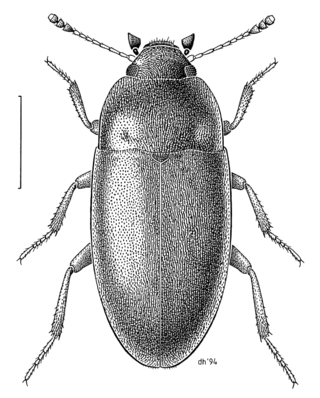
The family Archeocrypticidae is a small group of beetles with no vernacular common name, though recent authors have coined the name cryptic fungus beetles. Adults and larvae seems to be saprophagous and are often found in plant litter. Worldwide, about 10 genera and 50 species are found, most species are pantropical. Enneboeus caseyi has been recorded from the American South, Central America, and Mexico. About 20 species are found in Australia, in the genera Enneboeus,Australenneboeus and Gondwanenneboeus,Archeocrypticus,Falsoplatydema, Nothenneboeus, Sivacrypticus and Wattianus. They are largely absent from the Palearctic and Nearctic regions.

Ptiliinae is the largest subfamily of feather-winged beetles. About 80% of the described genera of these very tiny beetles are contained herein; however, many more genera and species await description.

Baranowskiella ehnstromi is the smallest known beetle in Europe. It lives only in the pores of the bracket fungus Phellinus conchatus, which grows on Salix caprea, and Phellinus punctatus, which grows on various deciduous trees. Its length is ca. 0.45–0.55 millimetres (0.018–0.022 in) and its width about 0.1 millimetres (0.0039 in).
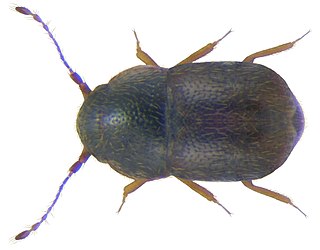
Baeocrara is a genus of featherwing beetles named because of the intricate structure of their flight wings, which have a long fringe of hairs on their borders. They belong to the Ptiliidae family, and are minute: between 1 and 0.5 mm. They are mostly found in hollow fir stumps and other types of rotten wood, dung and plant detritus. They feed on fungal spores. They seem to be recent immigrants to Northern Europe possibly introduced by the import of sawmill products. They have been reported in the Czech Republic. They are one of the least known groups in the Coleoptera.
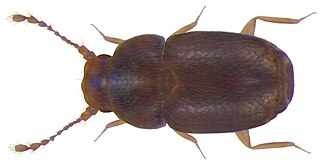
Pteryx is a genus of beetles that is typically found in northern bogs in the Northern Hemisphere. They belong to the family Ptiliidae which is referred to as feather-winged beetles as the hindwings are narrow and feather-like. Like most of the rest of the family, Pteryx are very small and live in rotting vegetative matter. They prefer rotting wood and are generally found under the bark of rotting logs or stumps.
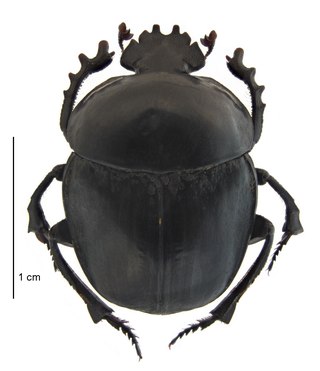
Sceliages, Westwood,, is a sub-genus of the Scarabaeus dung beetles, and are obligate predators of spirostreptid, spirobolid and julid millipedes, having renounced the coprophagy for which they were named. The genus is near-endemic to Southern Africa, Sceliages augias exceptionally ranging as far north as the Democratic Republic of Congo.
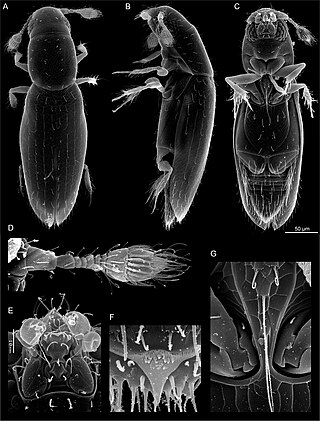
Scydosella is a genus of beetles that consists of only one species Scydosella musawasensis. The species is regarded as the smallest free-living insect, as well as the smallest beetle. They are among featherwing beetle, named because of their feather-like spiny wings. It was first discovered in Nicaragua, and described in 1999 by Wesley Eugene Hall of the University of Nebraska State Museum. The initial discovery consisted of very few specimens, and exact measurements were not conclusive. Because of their tiny size, they were difficult to observe under microscope after preservation. The generally accepted size was 0.300 mm in length. On 8 February 2015, Alexey Polilov of the Lomonosov Moscow State University collected 85 specimens in Chicaque National Park, Colombia. They were discovered on a layer of fungus on which they feed. From these specimens exact measurements could be made, and was found that the smallest individual is only 0.325 mm long. The largest individual is 0.352 mm long, and the average length of all the specimens is 0.338 mm. The body is elongated and oval in shape, yellowish-brown in colour, and its antennae are split into 10 segments.
Discheramocephalus brucei is a species of feather-winged beetle, the smallest beetles on earth, first found in Cameroon.
Discheramocephalus elisabethae is a species of feather-winged beetle, the smallest beetles on earth, first found in Cameroon.
Discheramocephalus mikaeli is a species of feather-winged beetle, the smallest beetles on earth, first found in Tanzania.
Discheramocephalus stewarti is a species of feather-winged beetle, the smallest beetles on earth, first found in Bolivia.
Discheramocephalus minutissimus is a species of feather-winged beetle, the smallest beetles on earth, first found in Indonesia. This species' adults have a body length of approximately 400 to 426µm. According to Grebennikov, the main factor limiting miniaturisation of female insects is an egg size significant enough in size to produce viable larvae. This size threshold is sometimes overcome, reaching limits of 180 and 130 µm in females and males, respectively, according to the author. Brain size is possibly the second most important factor limiting miniaturisation in this class.

Baranowskiella is a genus of beetles in the Ptiliidae family.

Trichoferus campestris, the velvet longhorned beetle, is a species of long-horned beetle in the family Cerambycidae.

Agrilus sulcicollis, the European oak borer, is a species of metallic wood-boring beetle in the family Buprestidae. It is found in Europe and Northern Asia and North America.
Discheramocephalus is a genus of feather-winged beetles, the smallest beetles on earth, first found in Cameroon. It was originally described in 2007 as a monotypic genus. Six additional species were added in 2008, and two were added in 2013.
Discheramocephalus semisulcatus is a species of feather-winged beetle, the smallest beetles on earth.

Discheramocephalini is a tribe of feather-winged beetles first proposed in 2009. It contains six extant genera, and one extinct genus.

Nephanes titan is a beetle from the Ptiliidae family of dwarf beetles. N. titan is notable for its exceptionally small body and simple nervous system. With an average maximum body length of only a few hundred micrometers, the beetle is one of the smallest non-parasitic insects in the world.











